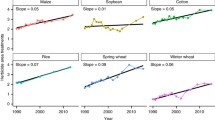Abstract
In Europe, regulations for release and placing-on-the-market of genetically modified (GM) crops require post-release monitoring of their impact on the environment. Monitoring potential adverse effects of GM crops includes direct effects as well as indirect effects, e.g. GM crop specific changes in land and pest management. Currently, there is a gap in the pre-release risk assessments conducted for regulatory approval of GM herbicide resistant (HR) crops. Since the relevant non-selective herbicides have been registered many years ago, in current dossiers requesting regulatory approval of GM HR crops, the environmental impacts of the corresponding non-selective herbicides are either entirely omitted or the applicant simply refers to the eco-toxicological safety assessments conducted for its original pesticide approval that do not address environmental issues arising in conjunction with the cultivation of GM HR crops. Since the ‘Farm-scale Evaluations’, it is clear that consequences for farmland biodiversity can be expected. The objective of this project was to identify relevant indicator species for the long-term impact of GM HR maize cultivation and the application of their corresponding non-selective herbicides, glyphosate and glufosinate. In this article, we describe the outcome of a modified Event Tree Analysis, essentially a funnel-like procedure allowing to reduce the large number of potentially affected non-target species to those with greatest ecological relevance and highest risk to be adversely affected based on a number of ecological criteria. This procedure allowed us to identify a total of 21 weed-Lepidoptera associations that we proposed for post release monitoring of GM HR maize in Germany.


Similar content being viewed by others
References
Brookes G, Barfoot P (2006) GM crops: the first 10 years—Global socio-economic and environmental impacts. ISAAA Brief No. 36 www.pgeconomic.co.uk./pdf/global_impactstudy_2006_v1_finalPGEconomics.pdf (last checked: February 2008)
Burke M (2005) Managing GM crops with herbicides: Effects on farmland wildlife. Farm Scale Evaluation Research Consortium www.defra.gov.uk/environment/gm/fse/results/fse-summary-05.pdf
Burke M (2003) GM crops: effects on farmland wildlife. Farmscale Evaluation Research Team and the Steering Committee. www.defra.gov.uk/environment/gm/fse/results/fse-summary-03.pdf
Friends of the Earth International Report (2007) Who benefits from GM crops? An analysis of the global performance of GM crops (1996–2006). www.foe.co.uk/resource/reports/who_benefits_from_gm_crops.pdf
Garcia MA, Altieri MA (2005) Transgenic crops: implications for biodiversity and sustainable agriculture. Bull Sci Technol Soc 25:335–353
Haeupler H, Muer T (2000) Bildatlas der Farn- und Blütenpflanzen Deutschlands. Verlag Eugen Ulmer, Stuttgart
Hawes C, Haughton AW, Osborne JL et al (2003) Responses of plants and invertebrate trophic groups to contrasting herbicide regimes in the Farm Scale Evaluations of genetically modified herbicide-tolerant crops. Philos Trans R Soc Lond B Biol Sci 358:1899–1913
Hayes KR (1998) Ecological risk assessment for ballast water introductions: a suggested approach. ICES J Mar Sci 55:201–212
Hayes KR, Gregg PC, Gupta VVSR, Jessop R, Losndale M, Sindel B, Stanley J, Williams C (2004) Identifying hazards in complex ecological systems. Part 3: Hierarchical Holographic Model for herbicide tolerant oilseed rape. Environ Biosafety Res 3:1–20
Heap I (2007) International survey of herbicide resistant weeds. www.weedscience.org/in.asp
Hoogeveen YR, Petersen J-E, Gabrielsen P (2002) Agriculture and biodiversity in Europe. Council of Europe, Strasbourg
James C (2006) Global status of commercialized biotech/GM crops: 2006. ISAAA Brief 35
Meier M, Hilbeck A (2005) Faunistische Indikatoren für das Monitoring der Umweltwirkungen gentechnisch veränderter Organismen (GVO). Naturschutz und Biologische Vielfalt 29:137
National Research Council (2002) Risk assessment models: environmental effects of transgenic plants—the scope and adequacy of regulation. National Academy Press, Washington DC
Perry JN, Firbank LG, Champion GT, Clark SJ, Heard MS, May MJ, Hawes C, Squire GR, Rothery P, Woiwod IP, Pidgeon JD (2004) Ban on triazine herbicides likely to reduce but not negate relative benefits of GM HT maize cropping. Nat Biotechnol 428:313–316
Van Gessel MJ (2001) Glyphosate-resistant horseweed from Delaware. Weed Sci 49:703–705
Acknowledgements
This work was supported by the German Federal Agency for Nature Conservation with funds of the German Ministry for Environment, Nature Conservation and Nuclear Safety.
Author information
Authors and Affiliations
Corresponding author
Rights and permissions
About this article
Cite this article
Hilbeck, A., Meier, M. & Benzler, A. Identifying indicator species for post-release monitoring of genetically modified, herbicide resistant crops. Euphytica 164, 903–912 (2008). https://doi.org/10.1007/s10681-008-9666-9
Received:
Accepted:
Published:
Issue Date:
DOI: https://doi.org/10.1007/s10681-008-9666-9




